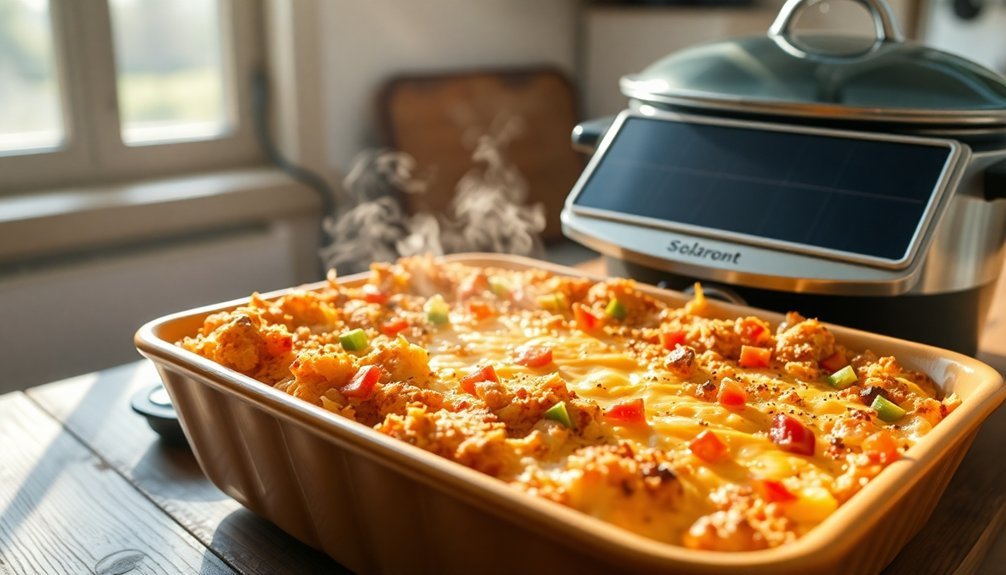Start your solar breakfast casserole journey by timing your prep perfectly – assemble ingredients the night before and remove from the fridge 30 minutes before sunrise to guarantee even heating in your solar oven. You'll want to layer your ingredients strategically: start with buttered bread cubes, followed by pre-cooked sausage, sautéed veggies, and cheese, then pour your seasoned egg mixture over top. For make-ahead convenience, you can freeze your assembled casserole up to a month ahead – just thaw overnight before baking. These fundamental tips will set you up for solar cooking success, but there's so much more to discover about mastering this eco-friendly breakfast technique.
Perfect Timing for Solar Success

Starting your day with a perfectly timed solar breakfast casserole requires strategic preparation.
You'll need to begin the night before by cooking and draining your sausage thoroughly, then combining it with hash browns, cheese, and vegetables in a large bowl.
In a separate container, mix your eggs, milk, mustard, and seasonings before incorporating them with the other ingredients.
Pour your mixture into a greased 13×9 inch baking dish and cover it tightly before refrigerating. This essential overnight rest of at least 8 hours allows the flavors to meld and ingredients to properly set.
You'll want to remove the casserole from the refrigerator 30 minutes before cooking to guarantee even heating.
When you're ready to bake, preheat your solar oven to maintain a steady 350°F. The casserole needs 65-70 minutes of uncovered baking time, or until it's golden brown and reaches an internal temperature of 165°F.
Consider adding fresh salsa as a vibrant topping when serving to enhance the flavors.
If you notice the top browning too quickly, tent it with foil. Once done, let it rest for 10 minutes before serving to achieve the perfect texture and temperature.
Layer Like a Pro
Building on proper timing, the art of layering your solar breakfast casserole determines its ultimate success. Start by greasing a 9×13-inch baking dish and arranging trimmed white bread cubes in a single, even layer. For the tastiest results, use sourdough sandwich bread for the best texture and flavor absorption. If you'd like extra crunch, toast the bread while you're preparing the other ingredients.
Cook your sausage over medium-high heat until it's no longer pink, breaking it into bite-sized pieces as you go. You can substitute ground turkey, beef, or chicken if you prefer. Add onions, garlic, peppers, mushrooms, and spinach to the skillet, cooking until they're slightly softened. Spread this mixture evenly over your bread layer.
Layer half the sharp cheddar cheese over your protein and vegetables, followed by bell peppers and seasonings. You'll want to repeat these layers with your remaining ingredients.
For the final layer, whisk together eggs, milk, salt, and pepper, then pour this mixture evenly over everything. Don't forget to add a final sprinkle of seasonings on top.
Cover your masterpiece with plastic wrap or foil before refrigerating overnight, and remember to let it rest at room temperature before cooking.
Make-Ahead Solar Breakfast Magic

For hassle-free mornings, make-ahead breakfast casseroles are your secret weapon. When you're planning a solar-cooked breakfast casserole, you'll want to prep everything the night before.
Start by cooking your sausage thoroughly and sautéing your vegetables to remove excess moisture. Once you've layered your ingredients in a greased 9×13-inch baking dish, cover it and pop it in the refrigerator for up to 24 hours. This convenient dish requires only 1 hour of prep spread across the preparation period.
- If you're planning further ahead, you can freeze your assembled casserole before baking. Just remember to thaw it overnight in the refrigerator when you're ready to use it.
- Let your casserole sit at room temperature briefly before placing it in your solar oven to remove the chill.
- You'll know your casserole is ready when the eggs are completely set, which typically takes 45-75 minutes at 325°F in a conventional oven (adjust time for solar cooking).
- If the top starts browning too quickly, cover it with foil to prevent burning.
Remember to let your casserole cool slightly before serving – this helps it set properly. For an extra touch, garnish with sliced green onions just before serving.
Frequently Asked Questions
Can I Substitute Frozen Hash Browns With Freshly Grated Potatoes?
Yes, you can substitute frozen hash browns with fresh ones, but you'll need to thoroughly dry the grated potatoes and potentially par-cook them first to achieve similar texture and prevent sogginess in your dish.
How Do I Adjust Cooking Time on Cloudy or Partly Cloudy Days?
On cloudy days, you'll need to extend your cooking time by 1.5 to 2 times longer than usual. Keep checking your solar oven's temperature and adjust accordingly. Remember, it won't cook effectively below 180°F.
What's the Best Pan Material to Use in a Solar Oven?
You'll get the best results with dark metal pots like granite ware or enamelware. They absorb heat quickly and efficiently. Don't use shiny pots – they'll reflect sunlight away. Cast iron works but heats slowly.
Will Condensation Affect the Casserole's Texture in the Solar Oven?
Yes, you'll notice condensation affects your casserole's texture. Without proper venting, trapped moisture can make it overly wet. Using a cloth under the lid or leaving a small vent helps control moisture levels.
Can I Double the Recipe While Keeping the Same Solar Cooking Time?
No, you can't maintain the same cooking time when doubling a recipe in a solar cooker. You'll need to extend your cooking time by roughly 1-2 hours to guarantee even heating throughout the larger portion.
In Summary
You'll love how this sunrise solar breakfast casserole brings ease and flavor to your morning routine. Perfect timing, strategic layering, and make-ahead preparation let you harness the sun's energy while you sleep. Whether you're camping, living off-grid, or simply wanting to cook sustainably, these three tips guarantee your solar breakfast casserole turns out perfectly every time. Start tomorrow with this eco-friendly, delicious meal.





Leave a Reply